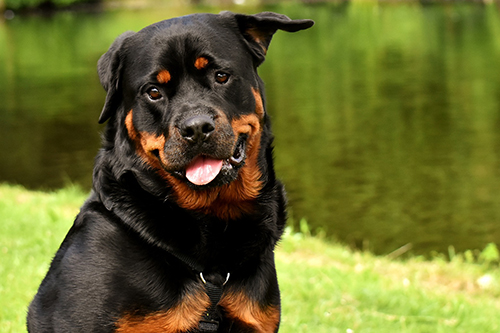The study led by the University of Bristol Veterinary School in collaboration with Cardiff University and Royal Veterinary College (RVC) London, and using data from VetCompass™ and Veterinary Pathology Group (VPG) histology, looked at the epidemiology surrounding which dog breeds get osteosarcoma, and what this means for canine welfare. This study also shows the huge benefits from studying dogs as a model to study this cancer. The findings are published in Canine Medicine and Genetics today [10 March].
The study included 1,756 laboratory-confirmed osteosarcoma cases in dogs compared with 905,211 dogs under veterinary care in the VetCompass™ database during 2016.
The research team found twenty-seven breeds, mainly larger breeds, had an increased risk of osteosarcoma compared to crossbreeds. Thirty breeds, mainly smaller breeds, including Jack Russell, Border Terrier, Bichon Frise, French Bulldog, Cavalier King Charles Spaniel, had reduced risk of osteosarcoma compared to crossbreeds.
The study also compared various measures of body mass and leg length, and confirmed previous findings that heavier dogs with longer legs and longer skull shapes are at greatest risk of bone tumours. The results could inform breed health reforms, especially in predisposed breeds such as the Rottweiler, Great Dane and Rhodesian Ridgeback, Mastiff and German Pointer. Whereas previous studies have identified high-risk breeds for bone tumours, this paper is novel by being able to identify breeds at lowest risk because of the huge size of the study population. The breeds identified here could be researched and compared to recognise novel genetic differences which cause bone tumours.
The findings that bone tumours are more common in certain breeds and conformations indicates that a dog’s genetics play a role in bone tumour development. This link between the biology of conformation and the biology of bone tumours in dogs provides valuable opportunities for further study into what causes bone tumours to develop, and how they could be treated in the future.
Osteosarcoma can affect any dog breed. However, owners of high-risk breeds should be especially alert for signs of the disease. These include lameness and painful, bony swelling and dog owners should contact their vet if concerned.
Dr Grace Edmunds, Clinical Veterinary Research Fellow and lead author at Bristol Veterinary School, said: "As a vet, I am always focussed on improving animal welfare by looking outwards to find new treatments for their diseases. As osteosarcoma also affects adolescents, it is hugely exciting that by understanding the biology of bone tumours, and working with my collaborators in human cancer research, we may make a difference to both canine and human cancer patients."
Dr Dan O'Neill, Senior Lecturer in Companion Animals Epidemiology at the RVC, added: "There are increasing concerns about the wisdom of breeding dogs with extreme body shapes such as flat-faced breeds like French Bulldogs or breeds with long backs such as Dachshunds.
"This study highlights the health risks from another extreme body shape - large body size. The breeds at highest risk of osteosarcoma were large-sized breeds such as Rottweiler, Great Dane and Mastiff. To reduce the risks of picking a dog that may develop bone cancer, owners may need to consider choosing puppies from smaller-sized parents of these giant breeds or opting for different smaller breeds instead."
Professor Rachel Errington at Cardiff University explained: "As a human cancer researcher at the School of Medicine this study shows that we can propose similar questions in human and canine disease with the aim of determining new therapies and diagnostics for both and this provides an exciting opportunity of joining forces across a diverse group of expertise."
The research team is currently developing a project that will sequence certain genes in at-risk and protected breeds for osteosarcoma, with the aim of identifying those genetic pathways that cause bone tumours to develop from normal bone. Identifying such pathways will allow new drugs, or older, repurposed drugs, to be used to see if the outcomes when treating bone tumours in dogs can be improved.
Drs Grace Edmunds and Helen Winter, members of the study team, will be engaging with owners of dogs with cancer and younger patients who have had cancer as part of a One Health approach, and they would welcome contact from patients or dog owners who would like to participate in this research.
Paper
'Dog breeds and body conformations with predisposition to osteosarcoma in the UK: a case-control study' by G. Edmunds et al. (2021) in Canine Medicine and Genetics [open access]
